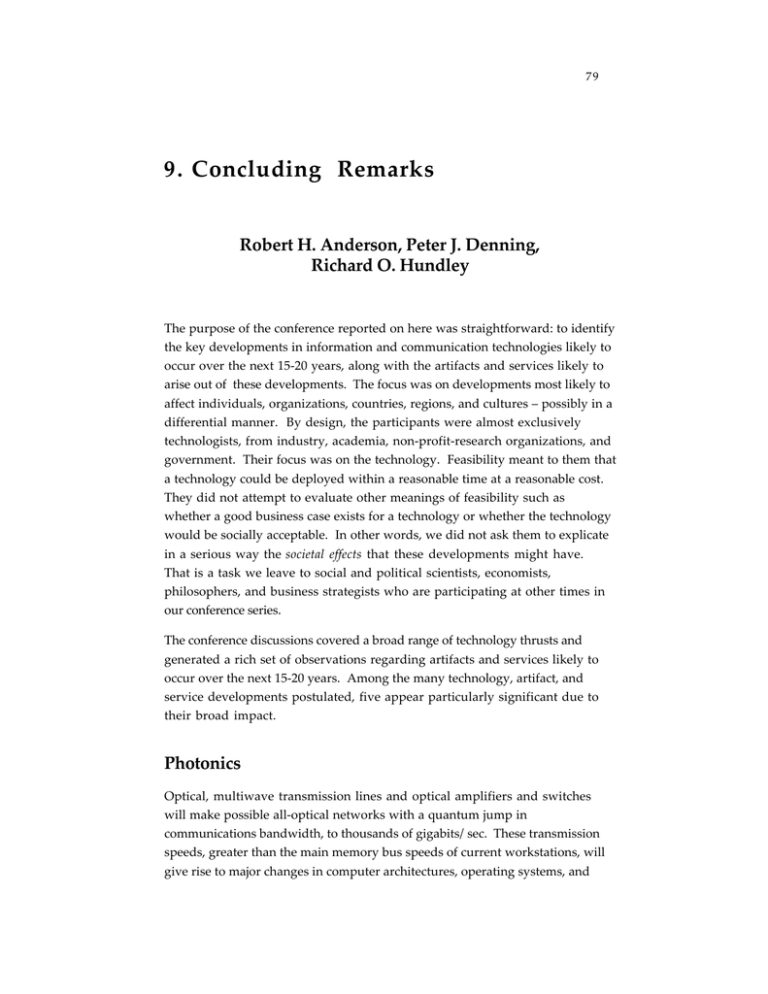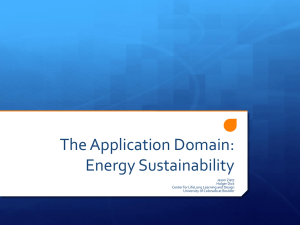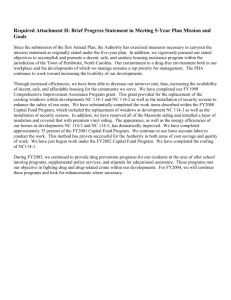9. Concluding Remarks Robert H. Anderson, Peter J. Denning, Richard O. Hundley
advertisement

79 9. Concluding Remarks Robert H. Anderson, Peter J. Denning, Richard O. Hundley The purpose of the conference reported on here was straightforward: to identify the key developments in information and communication technologies likely to occur over the next 15-20 years, along with the artifacts and services likely to arise out of these developments. The focus was on developments most likely to affect individuals, organizations, countries, regions, and cultures – possibly in a differential manner. By design, the participants were almost exclusively technologists, from industry, academia, non-profit-research organizations, and government. Their focus was on the technology. Feasibility meant to them that a technology could be deployed within a reasonable time at a reasonable cost. They did not attempt to evaluate other meanings of feasibility such as whether a good business case exists for a technology or whether the technology would be socially acceptable. In other words, we did not ask them to explicate in a serious way the societal effects that these developments might have. That is a task we leave to social and political scientists, economists, philosophers, and business strategists who are participating at other times in our conference series. The conference discussions covered a broad range of technology thrusts and generated a rich set of observations regarding artifacts and services likely to occur over the next 15-20 years. Among the many technology, artifact, and service developments postulated, five appear particularly significant due to their broad impact. Photonics Optical, multiwave transmission lines and optical amplifiers and switches will make possible all-optical networks with a quantum jump in communications bandwidth, to thousands of gigabits/sec. These transmission speeds, greater than the main memory bus speeds of current workstations, will give rise to major changes in computer architectures, operating systems, and 80 networking protocols. Application software will also change, probably becoming much more distributed as communications capabilities expand and costs decrease dramatically. Optical signaling will truly be a disruptive technology: disruptive to the computer industry and to the communications industry, potentially as disruptive as the transition from mainframes to microcomputers in the 1970s and 1980s. Many present-day leaders in the computer and communications industries will be threatened with extinction. Universal Connectivity The continued explosion in wireless communications, in a variety of forms, will result in anywhere/anytime connectivity -- the ability to connect with anyone on earth at any time of the day or night. This will enable a wide variety of other artifacts and services. It will affect business practices, international financial institutions, and governments. Ubiquitous Computing Computers will be everywhere. Small, powerful, inexpensive computers will be part of smart home appliances, smart houses, smart offices, smart buildings, smart automobiles, smart highways, etc., where they will perform a variety of embedded functions. Wearable and implanted computers will be increasingly important aids, also performing a variety of functions. Computers will be so ubiquitous that we will no longer think of many of them as “computers.” They will fade into the background, becoming part of the landscape. Pervasive Sensors Sensors will be everywhere as well. Diverse, powerful, inexpensive sensors capable of (limited-distance) wireless communication will increasingly couple the physical world to the cyber world. These will include tiny video cameras, MEMS microphones, accelerometers, gyros, GPS receivers providing location information, smell sensors, food spoilage sensors, biosensors, polymer-based sensors, etc. These sensors will enable a wide variety of new services. As these sensors increasingly monitor human activities – so that cyberspacebased services may better serve those humans – concerns regarding individual privacy will continue to mount and will demand solutions. 81 Global Information Utilities A dream of the designers of 1960s time-sharing systems is about to come true: Over the next 20 years we will be able to plug information appliances into wall sockets in much the same way as we now plug electrical appliances. Just as we obtain electricity, gas, water, and telephone from wires and pipes to our homes, so will we be able to obtain information services. * * * These five developments – photonics, universal connectivity, ubiquitous computing, pervasive sensors, and global information utilities – will enable a wide variety of other artifact and service developments over the next 20 years, many of which are discussed in these proceedings and some of which will turn out to have radical impact. When we look back from the vantage point of 2020, we are very likely to find these five developments among the “long poles in the tent” insofar as technology drivers of the information revolution during the period 2000-2020 are concerned. Invention, Innovation, and Market Forces All the technology, artifact, and service developments postulated in these proceedings are plausible. Not all of them will occur. Which ones will occur will depend on the manner in which the processes of invention (of new technology) and innovation (of new artifacts and services) play out over the next 20 years. Market forces will have much to say about this. The conference discussions made a beginning in dealing with such market forces (c.f. Section 6), but only a beginning; much more needs to be said and done. The expected centrality of the five key technologies mentioned above may be more or less predictable, but exactly which artifact and service developments flow successfully from them is not. Market forces will largely determine this – will largely determine the winners and losers over the next 20 years of the information revolution – as they have over the last 20 years. Although the discussion in Section 6 is only a beginning, it raised several interesting issues. One in particular merits note: Are the organizational loci of invention and innovation underlying the information revolution changing? • In the 1950s, 1960s, and early 1970s, the bulk of leading-edge IT invention and innovation occurred in universities and large commercial research laboratories, and was carried out (primarily but not entirely) by PhDs 82 driven by a “scientific” spirit that focused on the generation and propagation of ideas. • In the 1970s and 1980s, this began to change. University and large-company researchers still played a major role, but an ever increasing share of IT invention and innovation, particularly of new artifacts and services, was occurring in small, often embryonic organizations, and being carried out by non-PhDs – sometimes even college drop-outs11 -- driven by an entrepreneurial spirit that focused on transforming community practices in a relatively short time. Throughout the 1990s, this change accelerated. Today, the majority of IT innovation flows from smallish (often start-up) entrepreneurial organizations -- and not in large, well-established academic or commercial research establishments. And as this change has progressed, market forces have come to play an ever-increasing role at influencing what gets developed and what does not. The change in the dominant model of innovation has proved to be a contentious issue. How the balance will play out over the next 20 years is anyone’s guess. But the attempts to guess produced lively and sometimes heated exchanges in the breakout sessions. Nevertheless, we will as a field have to come to grips with these changes in the processes of innovation. How this plays out will be fundamental to an understanding of the future course of the information revolution. ______________ 11 E.g., Bill Gates.






